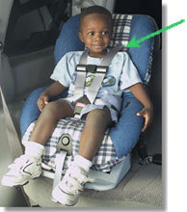In Spanish
In Hmong
In Somali
Installation Checklist 3: Forward-facing Convertible Car Seat
Do not use this seat unless your child is both over 1 year and over 20 pounds.
The American Academy of Pediatrics (AAP) recommends that all infants and toddlers should ride in a Rear-Facing Car Safety Seat until they are 2 years of age or until they reach the highest weight or height allowed by their car safety seat’s manufacturer.
Important: This is a general checklist designed to be used in combination with your vehicle owner’s manual and your child car seat instruction manual. To get the most out of this checklist, have those manuals handy for quick reference.
"Convertible" means the car seat can be used both forward facing and rear facing. There are three types of convertible seats; the five-point harness style is considered the safest.
___ 1) Check that the car seat is correct for the child's weight and height.- Weight: from 22 to 40 - 85 pounds.
- Height: Use until the child’s ears reach the top of the seat, when shoulders are above the top slots, or when the child reaches the weight maximum of the seat. When the child reaches these weight and height limits on the car seat, the child should move to a booster seat. (Height and weight limits vary by manufacturer; check labels on the car seat for specific limits.)
 ___ 2) Place the car seat in the back seat of vehicle. ___ 2) Place the car seat in the back seat of vehicle.- If the vehicle is an SUV or van with three rows of seats, place the car seat in the middle row.
- Place the car seat in the center of vehicle seat, if possible (see vehicle owner’s manual for details).
- The car seat should face the front of the vehicle.
___ 3) Select one method only to install the car seat.- Lap belt only (usually found in middle of back seat)
- Lap and shoulder belt
- LATCH system (Lower Anchors and Tethers for Children, built into the vehicle – see below)
___ 4) Attach the car seat.
Important: You must check labels on the car seat and the car seat instruction manual for information on how to attach the car seat using either the lap belt, lap and shoulder belt, or LATCH system. Also check your vehicle owner’s manual for instructions, including whether you need to use a locking clip. Be sure to check instructions for forward-facing position.- Position the car seat so the child rides sitting upright – see photo.
___ 5) Tighten the vehicle belt or lower anchor attachment (LATCH).- The car seat must not move more than one inch from side to side or front to back at the point of attachment. Have another person push down firmly on the child car seat while you tighten the vehicle belt, or kneel on the car seat yourself while you tighten the vehicle belt.
- Attach the top tether and tighten.
___ 6) Buckle the child into the car seat (see photo).- Use the right harness slots. Harness straps should be at or above the child’s shoulders for forward-facing. Some convertible car seats require the top slot for forward-facing – see the car seat instruction manual for information.
- Check that the harness straps are snug and flat on the child’s shoulders.
- Check that the plastic harness retainer clip is at the child’s armpit level.
- The child’s back should be flat against the back of the car seat.
Note: For tray shield convertible seats, be sure the tray is correctly positioned on the child.
Source: National Highway Traffic Safety Administration, U.S. Department of Transportation
See how to do it on video: "Safety Seats for Your Toddler" linked from http://www.chop.edu/carseat
|
|
|
|
|


 ___ 2) Place the car seat in the back seat of vehicle.
___ 2) Place the car seat in the back seat of vehicle.